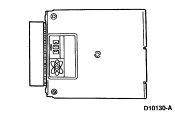
Section 07-01A: Transmission, Automatic, A4LD | 1993 Mustang Workshop Manual |
Electronic Control System, Actuators and Sensors
Electronic Control
Inputs
Outputs
Powertrain Control Module (PCM)
The operation of the A4LD automatic transmission is partially controlled by the Powertrain Control Module (PCM). Many input sensors provide information to the PCM, which then controls the actuators which affect the SS 3-4/4-3 solenoid and the torque converter clutch (TCC) solenoid during normal transmission operation.
Diagnostic Trouble Codes: 511, 512, 513 
Engine Coolant Temperature (ECT) Sensor
The Engine Coolant Temperature (ECT) Sensor detects the temperature of engine coolant and supplies the information to the Powertrain Control Module (PCM).
The ECT sensor is threaded into the heater outlet fitting or cooling passage on the engine. For engine control applications, the ECT signal is used to modify ignition timing, EGR flow, and air-to-fuel ratio as a function of engine coolant temperature. On electronic instrument cluster applications, the ECT output is used to control a coolant temperature indicator.
Transmission Function: ECT is used to control torque converter clutch operation.
Symptoms: Torque Converter Clutch will always be "OFF."
Diagnostic Trouble Codes: 116, 117, 118. 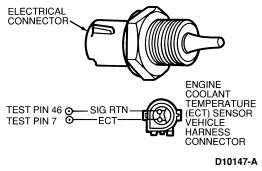
Brake On-Off (BOO) Switch
The Brake On-Off switch (BOO) tells the PCM when the brakes are applied. The switch is closed when the brakes are applied and open when they are released.
Transmission Function: Disengage torque converter clutch when brake is applied.
Symptoms: Failed "ON" — Torque converter clutch will not engage.
Failed "OFF" — Converter will not disengage when brakes are applied.
Diagnostic Trouble Codes: 536. 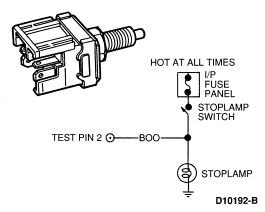
Electronic Ignition (EI) System
The Electronic Ignition (EI) System consists of a Crankshaft Position sensor (CKP), an EI Module, two four tower Coil Packs, and the PCM. The EI System operates by sending crankshaft position information from the CKP sensor to the EI module. The module generates a PIP signal (engine RPM) and sends it to the PCM.
Transmission Function: Uses RPM signal in the transmission strategy for 3-4 and 4-3 shift scheduling and torque converter clutch engagement.
Symptoms: No 3-4 or 4-3 shifts, no torque converter clutch engagement.
Diagnostic Trouble Codes: 211-217, 232. 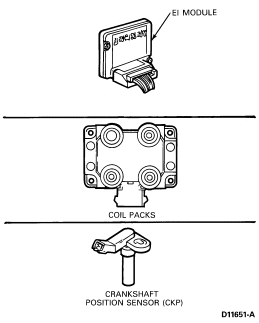
Profile Ignition Pulse (PIP) — Gasoline
On gasoline engines, the Profile Ignition Pulse (PIP) signal is produced by a Hall-Effect device in the distributor. It tells the PCM the engine RPM and the crankshaft position.
Transmission Function: Uses RPM signal in the transmission strategy for 3-4 and 4-3 shift scheduling and torque converter clutch control.
Symptoms: No 3-4 or 4-3 shifts, no torque converter clutch engagement.
Diagnostic Trouble Codes: 211-217. 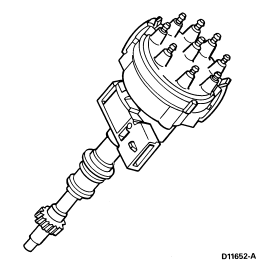
Throttle Position (TP) Sensor
The Throttle Position sensor (TP) is a potentiometer mounted on the throttle body. The TP sensor detects the position of the throttle plate and sends this information to the PCM as a varying voltage signal.
Transmission Function: Used in determining 3-4/4-3 shift scheduling and torque converter clutch engagement.
Symptoms: Abnormal shift schedule, torque converter clutch does not engage, torque converter clutch cycling.
Diagnostic Trouble Codes: 121, 122, 123, 125, 167. 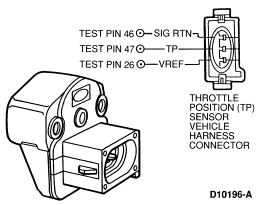
Vehicle Speed Sensor (VSS)
The Vehicle Speed Sensor (VSS) is a magnetic pickup that sends a signal to the PCM. This VSS signal tells the PCM the vehicle speed.
Transmission Function: Used in determining shift schedules and torque converter clutch control schedule.
Symptoms: No 3-4/4-3 shifts, no torque converter clutch engagement.
Diagnostic Trouble Codes: 452. 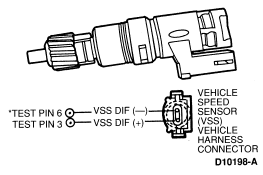
Torque Converter Clutch Solenoid (TCC)
The torque torque converter clutch solenoid (TCC) is used to control the apply and release of the torque converter clutch.
Transmission Function: Used to engage the torque converter clutch.
Symptoms: Failed "ON," the torque converter clutch would always be engaged above 30 mph.
Failed "OFF," the torque converter clutch will not engage.
Diagnostic Trouble Codes: 629, TCC solenoid circuit failure.
| Solenoid | PCM Signal Output Pin | KOEO On-Board Diagnostics |
|---|---|---|
| TCC | 53 or 14 | 89/629 |
| SS 3/4 | 52 or 51 | 86/566 |
Shift Solenoid 3-4 (SS 3-4)
The 3-4 shift solenoid is used to control the 3-4/4-3 shift valve.
Transmission Function: Used to shift from third gear to fourth gear, and fourth gear to third gear.
Symptoms: Failed "ON," vehicle has lack of acceleration performance at start out.
Failed "OFF," No 3-4 upshift or 4-3 downshift.
Diagnostic Trouble Codes: 566, 3-4 shift solenoid circuit
failure. 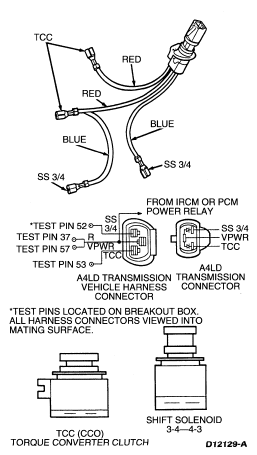
EEC-IV On-Board Diagnostic Trouble Code Description
| DTC | COMPONENT | DESCRIPTION | CONDITION | SYMPTOM/ACTIONS |
|---|---|---|---|---|
| 111 | SYSTEM | Pass | No fault detected. | Fault not detected by PCM. |
| 116 | ECT | ECT sensor out of on-board diagnostic range | ECT sensor signal higher or lower than expected during KOEO, KOER. | Rerun on-board diagnostic at normal operating temperature. |
| 117 | ECT | ECT below min voltage 125°C 254°F indicated | ECT sensor signal higher or lower than expected during KOEO, KOER. | TCC will always be off.a |
| 118 | ECT | ECT above max voltage -40°C-40°F | ECT sensor signal higher or lower than expected during KOEO, KOER. | TCC will always be off. 1 |
| 121 | TP | TP out of on-board diagnostic range | TP sensor not at idle position during KOEO. | Rerun on-board diagnostic at appropriate position. |
| 122 | TP | TP circuit below min voltage | Voltage above or below specification for on-board diagnostic or during normal vehicle operation. | Harsh engagements, firm shift feel, abnormal shift schedule, TCC does not engage.1 |
| 123 | TP | TP circuit above max voltage | Voltage above or below specification for on-board diagnostic or during normal vehicle operation. | Harsh engagements, firm shift feel, abnormal shift schedule, TCC does not engage.1 |
| 125 | TP | TP circuit voltage lower than expected | Voltage above or below specification for on-board diagnostic or during normal vehicle operation. | Harsh engagements, firm shift feel, abnormal shift schedule, TCC does not engage.1 |
| 167 | TP | Insufficient TP change during goose test | Throttle not depressed during KOER. | Rerun on-board diagnostic and depress throttle when indicated. |
| 211-213, 232 | RPM/PIP | RPM/PIP diagnostic trouble codes. | EI system has a malfunction which may cause a transmission concern. | No 3-4, 4-3, and no TCC engagement.1 |
| 211-213 | EI system | EI diagnostic trouble codes. | RPM/PIP — in an EI system has a malfunction which may cause a transmission concern. | No 3-4, 4-3, and no TCC engagement.1 |
| 452 | VSS | VSS circuit concern | Insufficient input from VSS sensor to PCM. | No 3-4, 4-3, and no TCC engagement.1 |
| 511 | PCM | Read Only Memory test concern | Read Only Memory test failure KOEO. | Rerun test.1 |
| 512 | PCM | Keep Alive Memory test concern | Keep Alive Memory test failure. | Rerun test.1 |
| 513 | PCM | Internal voltage concern | Internal voltage higher or lower than specification, failure KOEO. | Rerun test.1 |
| 536 | BOO | Brake not actuated during on-board diagnostic | Brake not cycled during KOER. | Rerun test.1 |
| 536 | BOO | BOO switch circuit failure | Brake on/off circuit failure. | Failed ON: TCC will not engage. Failed OFF: TCC will not disengage when brakes are applied.1 |
| 566b | SS 3-4 | SS 3-4 circuit fault KOEO | SS 3-4 circuit failure. | No 3-4, 4-3 shift. Refer to Pinpoint Test "A" . |
| 629b | TCC | TCC circuit concern | TCC circuit failure. | Failed ON: engine stalls at low idle speeds.
Failed OFF: no torque converter clutch engagements. Refer to Pinpoint Test "C" . |